Ventilation, at its core, is the process of introducing fresh air into a space while expelling stale or polluted air, ensuring a healthy and comfortable environment for occupants. In today’s rapidly urbanizing world, where we spend a significant portion of our lives indoors, the quality of the air we breathe has become paramount. From homes to offices, the role of effective ventilation cannot be overstated, not just for comfort but also for health, energy efficiency, and the longevity of the building itself.
This blog delves deep into the intricacies of ventilation, exploring its significance in improving indoor air quality and the science behind how it moves gases like carbon dioxide. We’ll also discuss the balance between energy efficiency and effective ventilation, the impact of climate on choosing the right system, and the tailored solutions required for different types of buildings.
Furthermore, we’ll shed light on the hidden dangers lurking in poorly ventilated spaces and emphasize the importance of comparing indoor and outdoor air quality. By the end, you’ll understand why proper ventilation is the cornerstone of a healthy building envelope and a crucial component in modern architectural design.
What is Ventilation: Why Fresh Air Matters For Indoor Quality
Ventilation is the process of exchanging or replacing air in any space to provide fresh air and improve indoor air quality. It involves the removal of stale air and its replacement with fresh outdoor air. This process is essential for removing moisture, odors, smoke, heat, dust, airborne bacteria, and other pollutants from an indoor environment.
The primary purpose of ventilation is to maintain good air quality in indoor spaces. It does this by diluting and displacing indoor pollutants. Without proper ventilation, indoor air can become filled with high concentrations of pollutants and airborne pathogens that can be harmful to health and comfort.
Fresh air is vital for various reasons:
- Health: Breathing in fresh air, as opposed to stale or polluted indoor air, reduces the risk of airborne diseases and respiratory issues. Pollutants may accumulate in poorly ventilated spaces, leading to health problems over time.
- Comfort: A well-ventilated space can prevent the buildup of odors and excess humidity, ensuring a comfortable indoor environment.
- Building Health: Proper ventilation can prevent damage to the building envelope from excess moisture, which can lead to mold growth and structural damage.
- Energy Efficiency: While it may seem counterintuitive, bringing in fresh outdoor air can sometimes help maintain the desired temperature and humidity levels in a building, reducing the strain on heating and cooling systems and potentially lowering cooling costs.
- Safety: In spaces with combustion appliances, ventilation is crucial to prevent the buildup of harmful gases, such as carbon dioxide and radon.
In essence, ventilation plays a pivotal role in ensuring that the air within our homes, offices, and other indoor spaces is clean, fresh, and safe to breathe. The American Society of Heating, Refrigerating, and Air-Conditioning Engineers (ASHRAE) provides guidelines on recommended ventilation rates to ensure optimal indoor air quality.
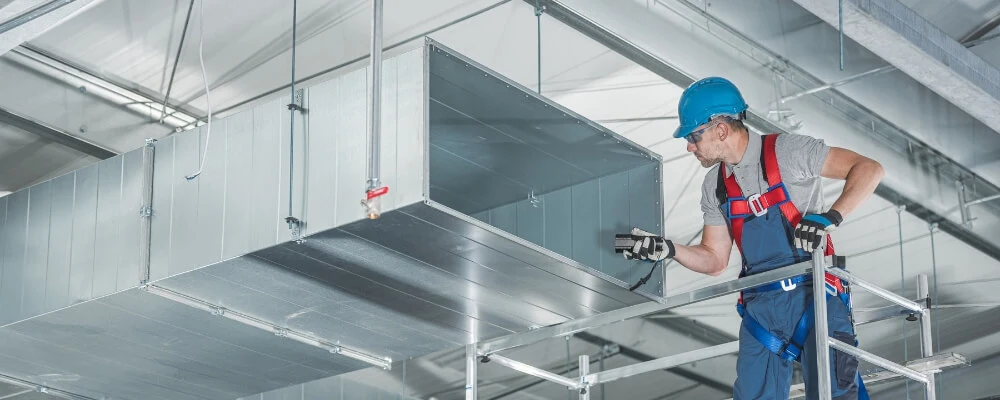
Components of Ventilation
Ventilation is a complex system that ensures the continuous flow of fresh air into a space and the removal of stale or polluted air. To achieve this, various components work in tandem, each playing a specific role. Here’s a breakdown of the primary components of a ventilation system:
Intake and Exhaust Vents
- Intake Vents: These are openings or ducts that allow fresh outdoor air to enter a building. They are typically located in areas where the air is cleanest, away from sources of pollution.
- Exhaust Vents: These vents expel stale or polluted air from the building. They are commonly found in areas like kitchens and bathrooms where moisture and odors accumulate.
Fans
- Mechanical ventilation systems rely on fans to move air. There are various types of fans, including axial, centrifugal, and cross-flow, each suited for specific applications. Fans can either draw in fresh air (supply fans) or push out stale air (exhaust fans).
Ducts
- Ducts are channels that transport air throughout a building. They connect different parts of a ventilation system, ensuring that air flows smoothly from intake to exhaust.
Filters
- Many ventilation systems incorporate filters to clean incoming air. Filters can trap particles, allergens, and sometimes even gases, ensuring that the introduced air is free from pollutants.
Dampers
- These are adjustable plates located within the ductwork. Dampers control the flow of air, allowing for adjustments based on the needs of the space.
Heat Exchangers
- Found in energy recovery ventilation systems, heat exchangers transfer heat from outgoing stale air to incoming fresh air during cold weather (and vice versa during warm weather). This process conserves energy by reducing the load on heating or cooling systems.
Sensors and Controls
- Modern ventilation systems often incorporate sensors that monitor factors like temperature, humidity, and air quality. Based on the data from these sensors, controls can adjust the ventilation rate, ensuring optimal indoor conditions.
Grilles and Diffusers
- These components help in the even distribution of air within a space. While grilles are protective or decorative covers for openings, diffusers evenly distribute air, preventing drafts or hot/cold spots.
Make-up Air Units
- In spaces where significant amounts of air are exhausted, like commercial kitchens, make-up air units introduce fresh air to balance the air pressure and prevent negative pressure situations.
Humidifiers/Dehumidifiers
- Depending on the climate and the specific needs of a space, ventilation systems might incorporate devices to add or remove moisture from the air, ensuring comfort and preventing issues like mold growth.
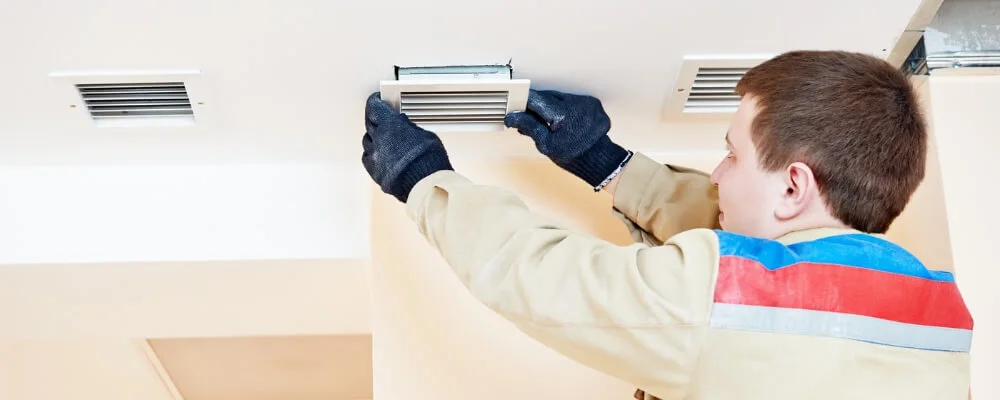
Types Of Ventilation
Ventilation is a crucial component of any building design, ensuring that indoor air remains fresh and free from pollutants. The type of ventilation chosen for a space can vary based on the building’s purpose, design, and climatic conditions. Here’s a breakdown of the primary types of ventilation:
1. Natural Ventilation
This type of ventilation relies on natural driving forces like wind and temperature differences to circulate air. It’s the most traditional form and involves the use of windows and doors, as well as other openings, to allow fresh outdoor air to replace indoor air. Natural ventilation is often preferred for its energy efficiency and ability to provide a connection with the outdoor environment.
2. Mechanical Ventilation
Mechanical ventilation systems use fans and ductwork to move air in and out of a building. There are several types of mechanical ventilation:
- Supply Ventilation: Brings in fresh air from outside, creating a positive pressure that pushes stale air out through leaks and openings.
- Exhaust Ventilation: Removes air from specific areas (e.g., bathrooms) where pollutants or moisture might accumulate, creating a negative pressure.
- Balanced Ventilation Systems: These systems both supply fresh air and exhaust stale air, ensuring a balanced flow of air throughout the building.
- Energy Recovery Ventilation: These systems recover energy from exhausted air and use it to precondition incoming fresh air, reducing energy loss.
3. Hybrid Ventilation
A combination of natural and mechanical ventilation systems, hybrid systems use mechanical aids to enhance the effectiveness of natural ventilation, especially during periods when natural forces might not be sufficient.
4. Spot Ventilation
This type targets specific areas of a building, using exhaust fans or supply fans. Examples include exhaust fans in bathrooms or ceiling fans in living areas.
5. Whole House Ventilation
As the name suggests, this type provides uniform ventilation throughout an entire building. It’s especially useful in tightly sealed homes where natural ventilation may not be adequate.
6. Positive Pressure Ventilation
This system introduces air into a building, usually after filtering and tempering it, to create a positive pressure. This ensures that any uncontrolled air leakage is from inside to outside, reducing the entry of pollutants.
7. Negative Pressure Ventilation
Opposite to positive pressure systems, these systems exhaust air from the building, ensuring that any uncontrolled air entering the building is from outside to inside.
Each type of ventilation serves a specific purpose and is suited to particular building designs, climates, and requirements. For instance, in warm and humid climates, exhaust ventilation systems might be more appropriate to remove moist air and prevent mold growth. Conversely, in colder regions, energy recovery ventilation can help in conserving heat.
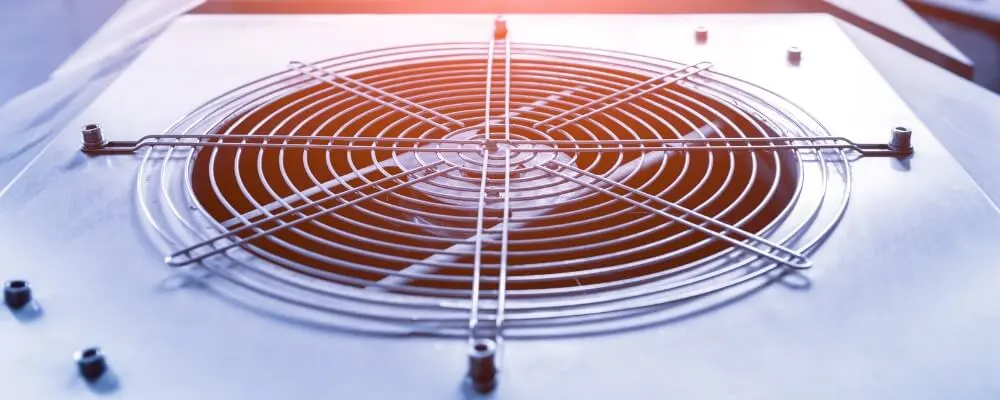
How Ventilation Systems Work
Understanding how ventilation systems work is crucial for ensuring optimal indoor air quality and energy efficiency. The operation of these systems can vary based on their design and the specific needs they address. Here’s an overview of how different ventilation systems function:
1. Natural Ventilation System
- Principle: Natural ventilation systems work based on the principle of natural driving forces like wind and temperature differences.
- Operation: When there’s a temperature difference between the inside and outside of a building, it creates a pressure difference. This pressure difference, combined with the effects of wind, drives the flow of air through openings like windows and doors. For instance, warm air rises and exits through upper openings, drawing in cooler air from lower openings.
2. Mechanical Ventilation Systems
- Principle: These systems use mechanical components, such as fans and ductwork, to control the flow of air.
- Operation: Fans either draw in fresh air from outside (supply ventilation) or expel stale air from inside (exhaust ventilation). In balanced ventilation systems, both processes happen simultaneously, ensuring a consistent airflow. Energy recovery ventilation systems work by capturing energy from the outgoing air and using it to treat the incoming air, optimizing energy efficiency.
3. Hybrid Ventilation
- Principle: Combines the benefits of natural and mechanical systems.
- Operation: Typically, the system will rely on natural ventilation when conditions are favorable (e.g., mild temperatures and adequate wind). When natural forces aren’t sufficient, mechanical systems kick in to assist.
4. Spot Ventilation
- Principle: Target specific areas or rooms.
- Operation: Exhaust fans in bathrooms or kitchens remove moisture and odors directly from the source. Supply fans might introduce fresh air into specific rooms.
5. Whole House Ventilation
- Principle: Provide consistent ventilation throughout an entire building.
- Operation: These systems often combine supply and exhaust ventilation to ensure that fresh air is introduced and stale air is removed uniformly across all rooms.
6. Positive and Negative Pressure Ventilation
- Principle: Control the direction of airflow based on pressure differences.
- Operation: Positive pressure systems introduce air, creating a higher pressure indoors and causing air to flow out. Negative pressure systems work in reverse, exhausting air and causing outdoor air to be drawn in.
The effectiveness of ventilation systems work also depends on factors like the airtightness of a building, the positioning of openings, and the design of the ductwork. Properly designed systems ensure that there’s adequate airflow, minimizing areas where stale air or pollutants may accumulate.
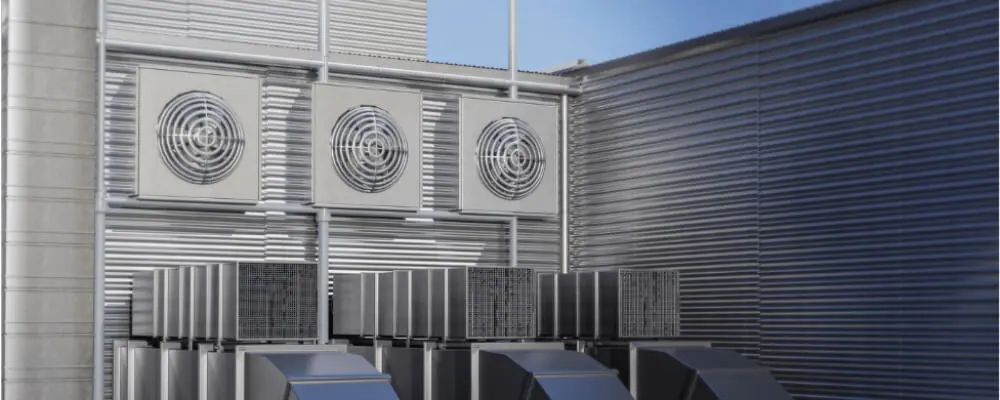
Natural Ventilation vs. Mechanical Ventilation
Ventilation is essential for maintaining good indoor air quality, but the method of achieving this can vary. Two primary approaches are natural ventilation and mechanical ventilation. Each has its advantages and disadvantages, and the choice between them often depends on the specific needs of a building and its occupants.
Let’s delve into the differences, benefits, and limitations of each:
1. Natural Ventilation
Natural ventilation relies on natural forces, such as wind and temperature differences, to move air in and out of a building. It typically involves the use of windows, doors, and other openings.
Advantages:
- Energy Efficiency: Since it doesn’t rely on mechanical systems, natural ventilation can be more energy efficient, leading to reduced energy costs.
- Connection with Nature: It provides a direct connection with the outdoor environment, enhancing occupants’ well-being.
- Low Maintenance: Without mechanical components, there’s less that can break down or require maintenance.
- Improved Air Quality: Continuous flow of fresh outdoor air can dilute indoor pollutants effectively.
Limitations:
- Less Control: It’s harder to regulate temperature and airflow, especially during extreme weather conditions.
- Security Concerns: Leaving windows and doors open can pose security risks.
- Potential for Pollutant Entry: In areas with high outdoor air pollution, natural ventilation might introduce pollutants into indoor spaces.
- Inconsistency: Wind and temperature can be unpredictable, leading to inconsistent ventilation rates.
2. Mechanical Ventilation
Mechanical ventilation systems use fans, ducts, and other mechanical components to control the flow of air in and out of a building.
Advantages:
- Control: Provides consistent and controlled air flow, regardless of external conditions.
- Flexibility: Can target specific areas (spot ventilation) or the whole house.
- Filtered Air: Many systems have filters that can remove outdoor air pollutants before introducing the air indoors.
- Humidity Control: Some mechanical ventilation systems can control indoor humidity levels, which is essential in humid climates or spaces like bathrooms.
Limitations:
- Energy Consumption: These systems require energy to operate, potentially increasing energy costs.
- Maintenance: Mechanical systems have components that can wear out and require regular maintenance.
- Initial Costs: Installation of mechanical ventilation systems can be more expensive than simply using openings for natural ventilation.
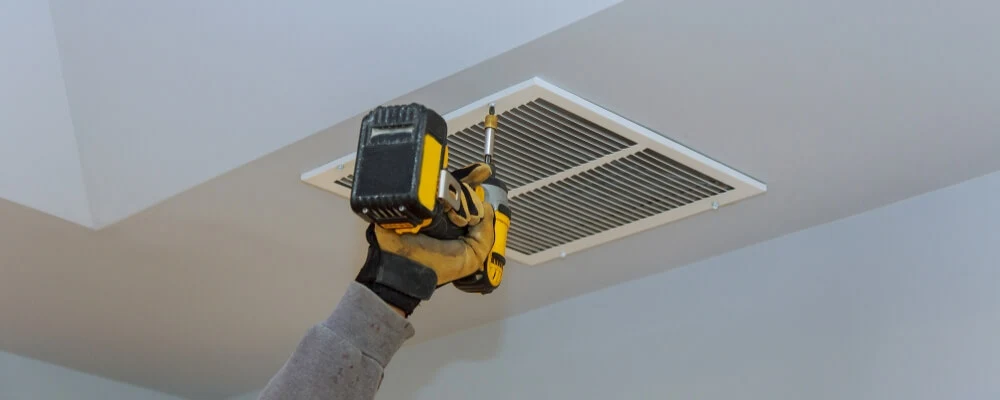
The Impact of Poor Ventilation on Health and Comfort
Ventilation is more than just a building requirement; it’s a critical component that affects the health and comfort of building occupants. Poor ventilation can have a range of negative consequences, from minor discomforts to severe health risks. Let’s explore the impact of inadequate ventilation:
Health Impacts
- Respiratory Issues: Stagnant indoor air can lead to the accumulation of pollutants, such as dust, pollen, and pet dander. Breathing in these pollutants can exacerbate respiratory conditions like asthma and allergies.
- Spread of Airborne Pathogens: Inadequate ventilation can facilitate the spread of airborne pathogens, including viruses and bacteria. This can increase the risk of respiratory infections among occupants.
- Carbon Dioxide Buildup: Poorly ventilated spaces can see a buildup of carbon dioxide, leading to symptoms like headaches, dizziness, shortness of breath, and, in extreme cases, impaired cognition.
- Exposure to Harmful Gases: Combustion appliances can release gases like carbon monoxide, a deadly, odorless gas. Without proper ventilation, these gases can accumulate, posing severe health risks.
- Mold Growth: Insufficient ventilation in humid areas can lead to moisture buildup, promoting mold growth. Mold spores can trigger allergic reactions and respiratory issues.
- Exposure to VOCs: Volatile Organic Compounds (VOCs) are emitted by certain paints, solvents, and other materials. Inadequate ventilation can lead to higher concentrations of VOCs, causing symptoms like nausea, dizziness, and throat irritation.
Comfort Impacts
- Unpleasant Odors: Without proper ventilation, odors from cooking, cleaning, or other activities can linger, making the indoor environment unpleasant.
- Temperature Fluctuations: Poor ventilation can lead to uneven temperatures, with some areas becoming too hot or too cold.
- Humidity Issues: Inadequate ventilation can lead to either excessively dry or humid conditions. Dry air can cause skin irritation and respiratory discomfort, while high humidity can make spaces feel stuffy and uncomfortable.
- Stale Air: A lack of fresh air can make indoor spaces feel stuffy and oppressive, leading to a sense of discomfort among occupants.
Long-Term Consequences
- Chronic Health Issues: Prolonged exposure to indoor air pollutants due to poor ventilation can lead to chronic respiratory and cardiovascular diseases.
- Decreased Cognitive Function: Some studies suggest that poor indoor air quality can impact cognitive function, affecting concentration, productivity, and even mood.
- Building Damage: Beyond health and comfort, poor ventilation can also damage the building itself. Excess moisture can lead to structural damage, peeling paint, and damaged furnishings.
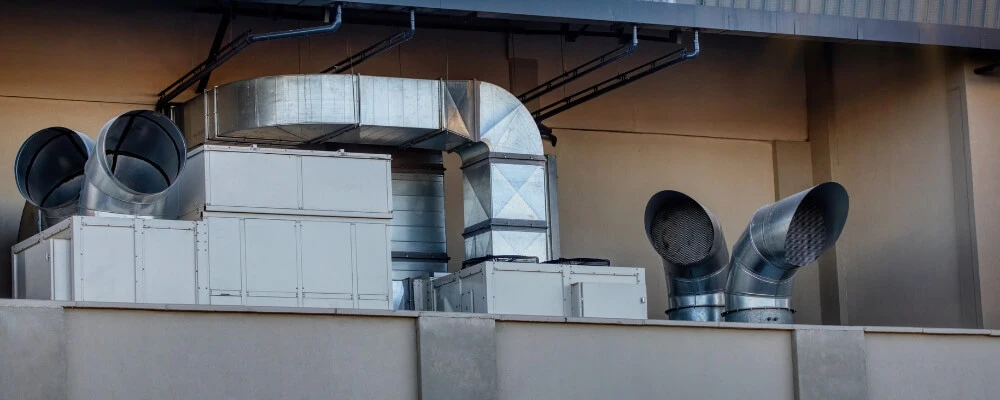
Improving Indoor Air Quality: The Role of Good Ventilation
Indoor air quality is paramount for the health and well-being of building occupants. Good ventilation plays a pivotal role in this by ensuring a continuous flow of fresh outdoor air, which dilutes and displaces indoor pollutants.
Whether it’s dust, volatile organic compounds, or airborne pathogens, effective ventilation systems help reduce their concentration, providing a healthier indoor environment. Moreover, by controlling humidity levels, good ventilation can prevent mold growth, further enhancing air quality.
Climate Considerations in Choosing the Right Ventilation System
The climate of a region can significantly influence the choice of a ventilation system. In humid climates, for instance, it’s essential to have ventilation that can effectively remove moist air, preventing mold growth and structural damage.
Conversely, in colder regions, energy recovery ventilation systems can capture heat from the exhausted air, reducing heating costs. Therefore, understanding the local climate is crucial when designing or selecting a ventilation system to ensure both efficiency and comfort.
The Science of Air: How Ventilation Moves Carbon Dioxide and Other Gases
Ventilation is not just about fresh air; it’s also about ensuring the safe removal of harmful gases. As we breathe, we exhale carbon dioxide. In poorly ventilated spaces, carbon dioxide levels can rise, leading to health issues.
Good ventilation ensures that carbon dioxide and other harmful gases, like those from combustion appliances, are effectively removed. The science behind this is simple: by creating pressure differentials and using natural or mechanical means, ventilation systems facilitate the flow of air, ensuring harmful gases are expelled and replaced with fresh air.
Energy Efficiency and Ventilation: Striking the Right Balance
While ventilation is essential for health and comfort, it’s also crucial to ensure that it doesn’t lead to unnecessary energy loss. Modern ventilation systems are designed to be energy efficient, balancing the need for fresh air with energy conservation.
For instance, energy recovery ventilation systems can capture and reuse energy from the exhausted air, reducing heating or cooling costs. By integrating smart designs and technologies, it’s possible to have effective ventilation without compromising on energy efficiency.
Ventilation Solutions for Different Types of Buildings
Different buildings have different ventilation needs. A residential home might benefit from a combination of natural and spot ventilation, while a large office building might require a more complex mechanical ventilation system.
Factors like building size, design, purpose, and occupancy rates all influence the choice of ventilation. By understanding these factors and the available solutions, it’s possible to design a ventilation system tailored to the specific needs of any building.
The Hidden Dangers of Carbon Dioxide in Poorly Ventilated Spaces
While carbon dioxide is a natural byproduct of respiration, in high concentrations, it can be harmful. Symptoms of elevated carbon dioxide levels include headaches, dizziness, shortness of breath, and, in extreme cases, impaired cognition.
Poorly ventilated spaces can see a rapid buildup of carbon dioxide, especially if they are densely occupied. Ensuring proper ventilation is not just about comfort; it’s a critical safety consideration.
Comparing Indoor and Outdoor Air: The Importance of Proper Ventilation
While outdoor air can sometimes be polluted, indoor air can often be much worse if not properly ventilated. This is because indoor spaces can concentrate pollutants from everyday activities like cooking and cleaning.
Proper ventilation ensures that there’s a continuous exchange between indoor and outdoor air, reducing the risk of indoor air pollution. It’s a critical component in ensuring that the air we breathe indoors is as clean, if not cleaner than the air outside.
Proper Ventilation: Key to a Healthy Building Envelope
A building’s envelope refers to its barriers against the external environment, including walls, roofs, and foundations. Proper ventilation ensures the health of this envelope by preventing issues like moisture buildup, which can lead to mold growth and structural damage.
Moreover, by controlling the flow of air, ventilation can reduce the strain on other building systems, like heating and cooling, ensuring the overall health and longevity of the building.

